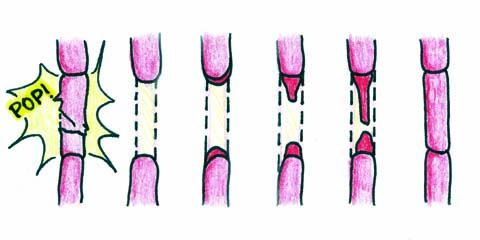
What else is cool about Griffithsia?
|
||
Bipolar Band Growth Algae have diverse methods for growing, the dominant types of growth are meristematic (including apical and intercalary) and diffuse growth, G. pacifica is interesting because it has both apical growth and intercalary elongation. Shoot cells grow by apical division at the rate of one to two cells per day (1), and branches are formed by the budding of subapical cells. The intercalary cells have an interesting pattern of elongation; it is confined to the top and bottom of each cell, creating two bands (meristems), while the portion in the middle does not elongate. This is called bipolar band growth. The figure to the left demonstrates this phenomenon. Charcoal grains were applied to newly budded cells (0 hr), and it can be seen that at the 24 and 46-hr marks the cells have doubled and tripled in size, respectively. The black brackets show which part of the cell is not elongating, as the bracket size is consistant, and it is interesting to note that the proximal growth band isn't elongating as quickly as the distal suggesting that the lower band is less active than the uppper band. This figure was modified from a photo taken by Waaland and Waaland in their 1972 study (2). |
||
 |
Cell Regeneration Griffithsia pacifica has served as a useful tool in analyzing processes such as regeneration of plants from single cells and the phenomenon of cell repair following injury (1). The figure to the left illustrates the process of cell repair by formation of a repair rhizoid from the superjacent cell and a repair shoot from the subajacent cell and their fusion in the space where an internodal cell had been punctured or popped (1). |
1) Bold, Harold C. and Michael J. Wynne. Introduction to the Algae. Englewood Cliffs: Prentice-Hall, Inc., 1978.
2) Waaland, Susan Drury, J. Robert Waaland and Robert Cleland. "A New Pattern of Plant Cell Elongation: Bipolar Band Growth." The Journal of Cell Biology 541972 184-190.
